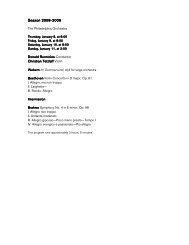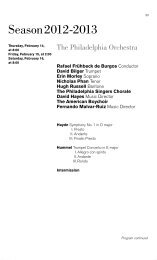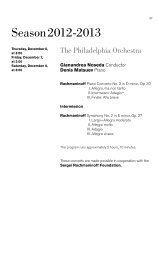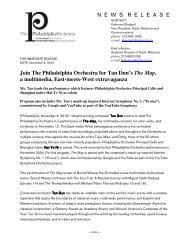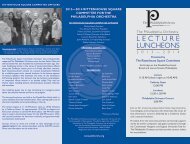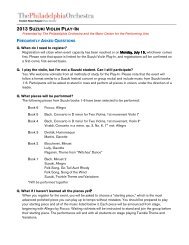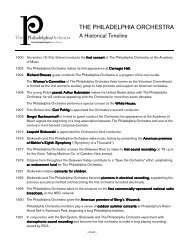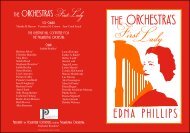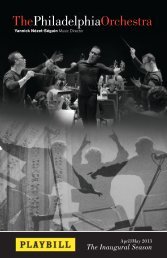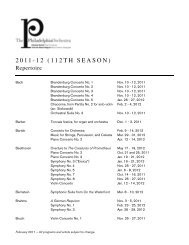Tchaikovsky's Fifth.pdf - The Philadelphia Orchestra
Tchaikovsky's Fifth.pdf - The Philadelphia Orchestra
Tchaikovsky's Fifth.pdf - The Philadelphia Orchestra
Create successful ePaper yourself
Turn your PDF publications into a flip-book with our unique Google optimized e-Paper software.
Season 2012-2013<br />
27<br />
Thursday, March 21, at 8:00<br />
Friday, March 22, at 2:00<br />
Saturday, March 23, at 8:00<br />
<strong>The</strong> <strong>Philadelphia</strong> <strong>Orchestra</strong><br />
Andrey Boreyko Conductor<br />
Colin Currie Percussion<br />
Wagner/arr. Zumpe “Entry of the Gods into Valhalla,”<br />
from Das Rheingold<br />
Rouse Der gerettete Alberich (Alberich Saved), fantasy<br />
for solo percussion and orchestra<br />
Intermission<br />
Tchaikovsky Symphony No. 5 in E minor, Op. 64<br />
I. Andante—Allegro con anima<br />
II. Andante cantabile, con alcuna licenza<br />
III. Valse: Allegro moderato<br />
IV. Andante maestoso—Allegro vivace<br />
This program runs approximately 1 hour, 50 minutes.<br />
<strong>Philadelphia</strong> <strong>Orchestra</strong> concerts are broadcast on<br />
WRTI 90.1 FM on Sunday afternoons at 2 PM.<br />
Visit www.wrti.org to listen live or for more details.
28 Story Title<br />
<strong>The</strong> <strong>Philadelphia</strong> <strong>Orchestra</strong><br />
Jessica Griffin<br />
Renowned for its distinctive<br />
sound, beloved for its<br />
keen ability to capture the<br />
hearts and imaginations<br />
of audiences, and admired<br />
for an unrivaled legacy of<br />
“firsts” in music-making,<br />
<strong>The</strong> <strong>Philadelphia</strong> <strong>Orchestra</strong><br />
is one of the preeminent<br />
orchestras in the world.<br />
<strong>The</strong> <strong>Orchestra</strong> has<br />
cultivated an extraordinary<br />
history of artistic leaders<br />
in its 112 seasons,<br />
including music directors<br />
Fritz Scheel, Carl Pohlig,<br />
Leopold Stokowski, Eugene<br />
Ormandy, Riccardo Muti,<br />
Wolfgang Sawallisch, and<br />
Christoph Eschenbach, and<br />
Charles Dutoit, who served<br />
as chief conductor from<br />
2008 to 2012. With the<br />
2012-13 season, Yannick<br />
Nézet-Séguin becomes the<br />
eighth music director of<br />
<strong>The</strong> <strong>Philadelphia</strong> <strong>Orchestra</strong>.<br />
Named music director<br />
designate in 2010, Nézet-<br />
Séguin brings a vision that<br />
extends beyond symphonic<br />
music into the vivid world of<br />
opera and choral music.<br />
<strong>Philadelphia</strong> is home and<br />
the <strong>Orchestra</strong> nurtures<br />
an important relationship<br />
not only with patrons who<br />
support the main season<br />
at the Kimmel Center but<br />
also those who enjoy the<br />
<strong>Orchestra</strong>’s other area<br />
performances at the Mann<br />
Center, Penn’s Landing,<br />
and other venues. <strong>The</strong><br />
<strong>Philadelphia</strong> <strong>Orchestra</strong><br />
Association also continues<br />
to own the Academy of<br />
Music, a National Historic<br />
Landmark.<br />
Through concerts,<br />
tours, residencies,<br />
presentations, and<br />
recordings, the <strong>Orchestra</strong><br />
is a global ambassador<br />
for <strong>Philadelphia</strong> and for<br />
the U.S. Having been the<br />
first American orchestra<br />
to perform in China, in<br />
1973 at the request of<br />
President Nixon, today <strong>The</strong><br />
<strong>Philadelphia</strong> <strong>Orchestra</strong><br />
boasts a new partnership<br />
with the National Centre<br />
for the Performing Arts<br />
in Beijing. <strong>The</strong> <strong>Orchestra</strong><br />
annually performs at<br />
Carnegie Hall and the<br />
Kennedy Center while also<br />
enjoying a three-week<br />
residency in Saratoga<br />
Springs, N.Y., and a strong<br />
partnership with the Bravo!<br />
Vail festival.<br />
<strong>The</strong> ensemble maintains<br />
an important <strong>Philadelphia</strong><br />
tradition of presenting<br />
educational programs for<br />
students of all ages. Today<br />
the <strong>Orchestra</strong> executes a<br />
myriad of education and<br />
community partnership<br />
programs serving nearly<br />
50,000 annually, including<br />
its Neighborhood Concert<br />
Series, Sound All Around<br />
and Family Concerts, and<br />
eZseatU.<br />
In February 2013 the<br />
<strong>Orchestra</strong> announced a<br />
recording project with<br />
Deutsche Grammophon,<br />
in which Yannick and<br />
the ensemble will record<br />
Stravinsky’s <strong>The</strong> Rite of<br />
Spring.<br />
For more information on<br />
<strong>The</strong> <strong>Philadelphia</strong> <strong>Orchestra</strong>,<br />
please visit www.philorch.org.
6<br />
Music Director<br />
Jessica Griffin<br />
Yannick Nézet-Séguin became the eighth music director<br />
of <strong>The</strong> <strong>Philadelphia</strong> <strong>Orchestra</strong> with the start of the 2012-13<br />
season. Named music director designate in June 2010, he<br />
made his <strong>Orchestra</strong> debut in December 2008. Over the past<br />
decade, Yannick has established himself as a musical leader<br />
of the highest caliber and one of the most exciting talents of<br />
his generation. Since 2008 he has been music director of the<br />
Rotterdam Philharmonic and principal guest conductor of the<br />
London Philharmonic, and since 2000 artistic director and<br />
principal conductor of Montreal’s Orchestre Métropolitain. He<br />
has appeared with such revered ensembles as the Vienna and<br />
Berlin philharmonics; the Boston Symphony; the Accademia<br />
Nazionale di Santa Cecilia; the Dresden Staatskapelle; the<br />
Chamber <strong>Orchestra</strong> of Europe; and the major Canadian<br />
orchestras. His talents extend beyond symphonic music into<br />
opera and choral music, leading acclaimed performances<br />
at the Metropolitan Opera, La Scala, London’s Royal Opera<br />
House, and the Salzburg Festival.<br />
Highlights of Yannick’s inaugural season include his Carnegie<br />
Hall debut with the Verdi Requiem, one world premiere, and<br />
performances of <strong>The</strong> Rite of Spring in collaboration with New<br />
York-based Ridge <strong>The</strong>ater, complete with dancers, video<br />
projection, and theatrical lighting.<br />
In July 2012 Yannick and Deutsche Grammophon announced<br />
a major long-term collaboration. His discography with the<br />
Rotterdam Philharmonic for BIS Records and EMI/Virgin<br />
includes an Edison Award-winning album of Ravel’s orchestral<br />
works. He has also recorded several award-winning albums<br />
with the Orchestre Métropolitain for ATMA Classique. In<br />
addition, his first recording with <strong>The</strong> <strong>Philadelphia</strong> <strong>Orchestra</strong>,<br />
Mahler’s Symphony No. 5, is available for download.<br />
A native of Montreal, Yannick studied at that city’s<br />
Conservatory of Music and continued studies with renowned<br />
conductor Carlo Maria Giulini and with Joseph Flummerfelt at<br />
Westminster Choir College. In 2012 Yannick was appointed<br />
a Companion of the Order of Canada, one of the country’s<br />
highest civilian honors. His other honors include Canada’s<br />
National Arts Centre Award; a Royal Philharmonic Society<br />
Award; the Prix Denise-Pelletier, the highest distinction for the<br />
arts in Quebec; and an honorary doctorate by the University<br />
of Quebec in Montreal.<br />
To read Yannick’s full bio, please visit www.philorch.org/conductor.
Conductor<br />
29<br />
Marcel Gruberman<br />
Andrey Boreyko, music director of the Dusseldorf<br />
Symphony, was born in Leningrad (now St. Petersburg)<br />
and received his musical education at his hometown’s<br />
conservatory, where he studied conducting and<br />
composition with Elisaveta Kudriavzeva and Alexander<br />
Dmitriev. Mr. Boreyko has performed with nearly<br />
every world-renowned orchestra, including the Berlin,<br />
Munich, New York, and Los Angeles philharmonics;<br />
the Staatskapelle Dresden; the Leipzig Gewandhaus,<br />
Russian National, Philharmonia, Royal Concertgebouw,<br />
and Cleveland orchestras; the RAI National Symphony in<br />
Turin; the Filharmonica della Scala in Milan; the Tonhalle<br />
<strong>Orchestra</strong> in Zurich; the Orchestre de la Suisse Romande;<br />
the Orchestre Philharmonique de Radio France; and the<br />
Vienna, London, BBC, Boston, and Chicago symphonies.<br />
He made his <strong>Philadelphia</strong> <strong>Orchestra</strong> debut in July 2006.<br />
Mr. Boreyko is also chief conductor of the Bern Symphony,<br />
as well as principal guest conductor of the Stuttgart Radio<br />
Symphony (SWR). In 2009 he was appointed principal<br />
guest conductor of the Basque National <strong>Orchestra</strong> in<br />
San Sebastian, Spain, a position he will hold through the<br />
2013-14 season. Past positions include chief conductor<br />
of the Jenaer Philharmonic in Germany; chief conductor<br />
of the Hamburg and Winnipeg symphonies; and principal<br />
guest conductor of the Vancouver Symphony. He is now<br />
the honorary conductor of the Jenaer Philharmonic where,<br />
in the course of his five-year term as chief conductor,<br />
the Board of Directors of the Deutscher Musikverleger-<br />
Verband, an association of music publishers in Germany,<br />
awarded him and the ensemble the distinction of best<br />
concert program for three seasons in succession.<br />
Numerous CDs, as well as TV and radio recordings,<br />
demonstrate Mr. Boreyko’s artistic versatility. Recent<br />
recordings include Arvo Pärt’s Lamentate as well as<br />
Valentin Silvestrov’s Symphony No. 6 with the Stuttgart<br />
Radio Symphony and released by ECM Records. In 2006<br />
Hänssler Classic released a live recording of Mr. Boreyko<br />
conducting the SWR in an all-Shostakovich album<br />
featuring the Fourth Symphony and the world premiere<br />
of the original version of the Suite from the opera Lady<br />
Macbeth of the Mtsensk District.
30<br />
Soloist<br />
Marco Borggreve<br />
Percussionist Colin Currie is the soloist of choice for<br />
many of today’s leading composers. From his earliest years<br />
he has forged a pioneering path in creating new music<br />
for percussion. He was awarded the Royal Philharmonic<br />
Society Young Artist Award in 2000 and received a<br />
Borletti-Buitoni Trust Award in 2005. Mr. Currie made<br />
his <strong>Philadelphia</strong> <strong>Orchestra</strong> debut in November 2005 as<br />
soloist for Jennifer Higdon’s Percussion Concerto. In 2012<br />
he performed Kalevi Aho’s new percussion concerto,<br />
Sieidi, with the London Philharmonic and Osmo Vänskä at<br />
London’s Southbank Centre, and premiered Elliott Carter’s<br />
Two Controversies and a Conversation with the New York<br />
Philharmonic and David Robertson. Other commissions<br />
have included works by Simon Holt, Kurt Schwertsik,<br />
Einojuhani Rautavaara, Alexander Goehr, Nico Muhly,<br />
Steve Reich, James MacMillan, and Louis Andriessen.<br />
In 2011 Mr. Currie was appointed artist in residence at the<br />
Southbank Centre, a role that allows him to develop new<br />
relationships with artists and ensembles across a variety<br />
of art forms, collaborations, and educational projects. In<br />
addition to these current performances in <strong>Philadelphia</strong>,<br />
highlights of the 2012-13 season include debuts with<br />
the Orchestre Philharmonique de Radio France, the<br />
Oslo Philharmonic, and at the Grafenegg Festival with<br />
the Goteborg Symphony, as well as returns to the BBC<br />
Philharmonic, the Orchestre National de Toulouse, the<br />
Britten Sinfonia, and the New Zealand, Melbourne, and<br />
Baltimore symphonies. Mr. Currie’s percussion ensemble,<br />
the Colin Currie Group, continues to receive critical<br />
acclaim for its performances of Reich’s iconic work<br />
Drumming. Following sell-out performances throughout<br />
the UK, in 2012 the group made its international debut<br />
with two performances at Tokyo Opera City in Japan.<br />
Mr. Currie’s recent recordings include Rautavaara’s<br />
Incantations with the Helsinki Philharmonic for Ondine<br />
and MacMillan’s Veni, Veni, Emmanuel with the<br />
Netherlands Radio Chamber Philharmonic for Challenge<br />
Classics. A recital disc, Borrowed Time, features music<br />
by Dave Maric and is available on the Onyx label. His<br />
recording of Higdon’s Percussion Concerto, conducted by<br />
Marin Alsop with the London Philharmonic, won a 2010<br />
Grammy Award.
Framing the Program<br />
31<br />
Parallel Events<br />
1853<br />
Wagner<br />
Das Rheingold<br />
1888<br />
Tchaikovsky<br />
Symphony<br />
No. 5<br />
Music<br />
Schumann<br />
Violin Concerto<br />
Literature<br />
Dickens<br />
Bleak House<br />
Art<br />
Courbet<br />
<strong>The</strong> Bathers<br />
History<br />
Tubman begins<br />
Underground<br />
Railroad<br />
Music<br />
Rimsky-<br />
Korsakov<br />
Sheherazade<br />
Literature<br />
Zola<br />
La Terre<br />
Art<br />
Toulouse-<br />
Lautrec<br />
Place Clichy<br />
History<br />
Jack the Ripper<br />
murders<br />
This year marks the bicentennial of Richard Wagner, the<br />
preeminent German opera composer of the 19th century<br />
and the most influential as well. Wagner spent more<br />
than a quarter century laboring on his four-part Ring of<br />
the Nibelung, one of the most ambitious undertakings<br />
in the history of music. <strong>The</strong> program today begins with<br />
the majestic “Entry of the Gods into Valhalla” concluding<br />
Das Rheingold, the preliminary opera that introduces the<br />
mythic themes explored in the rest of the cycle.<br />
Wagner’s title for the cycle might be rephrased as<br />
“Alberich’s Ring,” relating to the magical ring the Nibelung<br />
dwarf Alberich forges out of gold from the Rhine River<br />
and then places a curse on. Contemporary American<br />
composer Christopher Rouse has imaginatively continued<br />
the story of the Ring in his Der gerettete Alberich (Alberich<br />
Saved), a postlude in the guise of a percussion concerto<br />
that takes off from the final moments of the Ring at the<br />
end of Götterdämmerung. Rouse views the piece as a sort<br />
of “fantasy for solo percussionist and orchestra on themes<br />
of Wagner, with the soloist taking on the ‘role’ of Alberich.<br />
Much of the musical material in the work is derived from a<br />
number of motives associated with Alberich.”<br />
Wagner’s Ring is one of many operas that explore the<br />
theme of Fate—both in terms of plot and a musical motive.<br />
Fate attracted symphonic composers as well, such as<br />
Tchaikovsky in his spectacular <strong>Fifth</strong> Symphony. Like that<br />
other famous <strong>Fifth</strong>—Beethoven’s—it uses a musical motive<br />
throughout the four movements that is associated with the<br />
idea of “Fate.” <strong>The</strong> Symphony concludes with a double coda<br />
of sorts: an exciting one that could end the piece and then<br />
an additional triumphant one that ties everything together.
32<br />
<strong>The</strong> Music<br />
“Entry of the Gods into Valhalla,” from Das Rheingold<br />
Richard Wagner<br />
Born in Leipzig,<br />
May 22, 1813<br />
Died in Venice,<br />
February 13, 1883<br />
This year marks the bicentennial of the two leading<br />
Romantic opera composers: Richard Wagner and Giuseppe<br />
Verdi. Between them, this German and this Italian changed<br />
the genre of opera forever, each in his own distinctively<br />
brilliant manner. Wagner’s influence, moreover, extended<br />
far beyond music, with significant consequences for the<br />
other arts, cultural life, and politics. It is unprecedented for<br />
a composer, either before or since, to have such an impact<br />
on writers, artists, philosophers, and filmmakers. To mention<br />
just literature, Wagner’s works proved of great importance<br />
for figures such as Charles Baudelaire, Marcel Proust,<br />
James Joyce, and Thomas Mann.<br />
More has been written about Wagner than about any<br />
other Western composer. <strong>The</strong> flood began with his own<br />
voluminous writings, which encompass reviews, fiction,<br />
drama, essays, and books as well as diaries, countless<br />
letters, and a massive autobiography, My Life, covering<br />
just the first half of his career. In addition Wagner wrote<br />
his own librettos. His compositional output is also gigantic,<br />
although principally limited to dramatic music. <strong>The</strong> music<br />
he produced as a teenager—piano works, songs, and<br />
even a symphony—is almost uniformly mediocre; few<br />
composers ended up so far artistically from where they<br />
began. Wagner wrote 13 operas (the first three are rarely<br />
performed), with his mature achievements stretching from<br />
<strong>The</strong> Flying Dutchman (1843) through Parsifal, premiered a<br />
few months before he died at age 69 in February 1883.<br />
Forging the Ring Amidst this phenomenal productivity<br />
nothing was more ambitious than <strong>The</strong> Ring of the Nibelung<br />
on which Wagner toiled for more than a quarter century.<br />
<strong>The</strong> protracted project began in the revolutionary year of<br />
1848 when he devised a prose sketch for an opera based<br />
on medieval legends called Siegfrieds Tod (Siegfried’s<br />
Death, later renamed Götterdämmerung or Twilight of<br />
the Gods). A few years later he realized that this opera<br />
would need to be prefaced by an account of earlier<br />
events in Siegfried’s life, and thus sketched the libretto<br />
for Der junge Siegfried (Young Siegfried). Once again he<br />
felt that more background was necessary concerning the<br />
history of this mythic German hero and his ancestry. This<br />
led to Die Walküre (<strong>The</strong> Valkyrie), which explained the
33<br />
circumstances of his conception by the brother and sister<br />
Siegmund and Sieglinde. <strong>The</strong> librettos for a unified trilogy<br />
now complete, Wagner decided to add an extended oneact<br />
prologue, Das Rheingold (<strong>The</strong> Rhinegold), of which we<br />
hear the magnificent conclusion tonight.<br />
Wagner based the Ring on a variety of literary sources,<br />
principally drawn from Norse mythology of the early 13th<br />
century, from the somewhat earlier German epic Das<br />
Nibelungenlied as well as from Ancient Greece. Indeed,<br />
part of the ideological impetus behind the project was<br />
to accomplish for the German nation what Sophocles<br />
and other classical authors had done for Greece by<br />
dramatizing enduring mythology. Once he had written the<br />
librettos, and published them in 1853, he began writing<br />
the music, which would occupy much of the next 20<br />
years. Das Rheingold was finished in 1854, Die Walküre<br />
by 1856, and Siegfried half written when Wagner had a<br />
reality check: <strong>The</strong>se enormous operas had slim prospects<br />
for actual staged performances. He put the Ring aside<br />
to compose Tristan und Isolde and Die Meistersinger<br />
von Nürnberg. Only after completing those works, which<br />
assumed enormous proportions in themselves, did he<br />
return to Siegfried and Götterdämmerung, completing the<br />
Ring in 1874. Part of Wagner’s phenomenal achievement<br />
was crafting so expansive a four-part work—some 17<br />
hours of music—that is unified both dramatically and<br />
musically. He did this in part by weaving an elaborate web<br />
of leitmotivs (leading motives), brief melodies associated<br />
with specific characters, places, objects, and concepts<br />
that recur and are transformed throughout the cycle.<br />
<strong>The</strong> passionate patronage of King Ludwig II of Bavaria<br />
made the crucial difference in finally getting the Ring<br />
performed. At Ludwig’s insistence, but without Wagner’s<br />
participation, Das Rheingold and Die Walküre were<br />
mounted in Munich in 1869 and 1870. It was the<br />
construction of a new theater in Bayreuth, conceived<br />
of by Wagner to stage his mature operas and heavily<br />
subsidized by Ludwig, that enabled the premiere of the<br />
complete cycle in August 1876. As part of the effort to<br />
raise funds for Bayreuth, as well as to enlist subscribers in<br />
the venture, Wagner gave concerts in which he presented<br />
excerpts from the Ring. We might think of these as serving<br />
a purpose similar to movie “trailers” today—a preview of<br />
coming attractions. Some of the most famous parts of the<br />
Ring, such as the “Ride of the Valkyries,” were first heard in<br />
concert, sometimes with singers, sometimes not.
34<br />
Wagner composed Das<br />
Rheingold from 1853 to 1854.<br />
<strong>The</strong> <strong>Philadelphia</strong> <strong>Orchestra</strong><br />
first performed “<strong>The</strong> Entry of<br />
the Gods into Valhalla” on its<br />
very first concert, on November<br />
16, 1900, with Fritz Scheel<br />
on the podium. Most recently<br />
on subscription, the piece was<br />
performed as part of Henk<br />
de Vlieger’s arrangement of<br />
Wagner’s Ring called <strong>The</strong><br />
Ring: An <strong>Orchestra</strong>l Adventure,<br />
in December 2009, with<br />
Neeme Järvi.<br />
<strong>The</strong> score for this arrangement<br />
by Hermann Zumpe calls for<br />
pairs of flutes, oboes, clarinets,<br />
and bassoons, four horns, three<br />
trumpets, three trombones,<br />
tuba, timpani, percussion<br />
(cymbals), harp, and strings.<br />
<strong>The</strong> <strong>Orchestra</strong> has recorded<br />
this excerpt from Das<br />
Rheingold twice, both for<br />
RCA: in 1933 with Leopold<br />
Stokowski and in 1971 with<br />
Eugene Ormandy.<br />
Performance time is<br />
approximately 11 minutes.<br />
A Closer Look One section that Wagner himself<br />
programmed was the grand conclusion of Das Rheingold,<br />
which he called the “Entry of the Gods into Valhalla.”<br />
(Tonight we hear the excerpt in the purely orchestral<br />
instrumentation by Wagner’s colleague Hermann Zumpe.)<br />
This opera introduces the various gods and cursed ring at<br />
the heart of the cycle. It begins with three Rhinemaidens<br />
guarding a hoard of gold in the river Rhine. <strong>The</strong> dwarf<br />
Alberich, of the Nibelung clan, steals the gold, renounces<br />
love, and forges a magical ring that makes its possessor<br />
all-powerful. (<strong>The</strong> title of the entire work refers thus<br />
to Alberich’s ring.) <strong>The</strong> chief god Wotan gets the ring<br />
and over the course of Das Rheingold we witness the<br />
consequences of the curse Alberich has put on it. By the<br />
end of the opera Wotan has succeeded in having the<br />
giant Fafner build Valhalla, a grand home of the gods.<br />
<strong>The</strong> marvelous ending witnesses Wotan and other gods,<br />
including his wife, Fricka, as they cross a magical rainbow<br />
bridge to enter Valhalla. Amid luminous orchestration a<br />
number of prominent leitmotivs pass in review: Valhalla,<br />
the ring, gold. Wotan foresees that all he has dreamed<br />
and planned will come to pass, while Loge, the God of<br />
Fire, muses to himself “<strong>The</strong>y are hastening on to their<br />
end, though they think they are great in their grandeur”;<br />
he correctly envisions the “Twilight of the Gods” that<br />
will eventually end the entire Ring. <strong>The</strong> three invisible<br />
Rhinemaidens who began the opera are heard in the<br />
valley below, lamenting the loss of their gold: “Rhinegold!<br />
Rhinegold! Shining gold! Return to the deep, let us bathe<br />
in your light again! Goodness and truth dwell in the<br />
waters: false and base all those who dwell above!”<br />
—Christopher H. Gibbs
<strong>The</strong> Music<br />
Der gerettete Alberich<br />
35<br />
Christopher Rouse<br />
Born in Baltimore, Maryland,<br />
February 15, 1949<br />
Now living there<br />
If there is a thread that runs through Christopher Rouse’s<br />
orchestral works, it is the manner in which they seem to<br />
address—more directly and immediately than perhaps<br />
any other music being written for the concert hall today—<br />
the issues of joy, horror, violence, sensationalism, and<br />
passion that characterize life in our time. Rouse is, to this<br />
writer’s mind, the composer of his generation who most<br />
consistently confronts the challenges of modernism, not<br />
stooping to facile trends of neotonalism or commercial<br />
needs for accessible art. At the same time, he has felt<br />
free to mix blaring dissonance with tender Brucknerian<br />
quotations, strict sonata-form with rhapsodic fantasy, brutal<br />
percussive effects with the bright rhythms of rock ’n’ roll.<br />
A Romantic at Heart At the core of this technical<br />
aplomb is a sensitive individual with a subjective<br />
outlook on music and its purposes. “<strong>The</strong> fact that I<br />
had my undergraduate training in the late ’60s meant<br />
that I willingly tried my hand at all sorts of avant-garde<br />
approaches,” Rouse has said. “But I kept coming back to<br />
the notion that the technique involved was less important<br />
than my need to express, which must mean that I’ve<br />
always been a Romantic at heart!”<br />
His music has been performed by all of the major<br />
American orchestras, and by artists as varied as David<br />
Zinman, Simon Rattle, Riccardo Muti, Yo-Yo Ma, and Jan<br />
DeGaetani. He was composer in residence first for the<br />
Indianapolis Symphony, and from 1986 to 1989 for the<br />
Baltimore Symphony; he began a two-year tenure as<br />
composer in residence of the New York Philharmonic in<br />
2012. He is also currently a member of the composition<br />
faculty at the Juilliard School.<br />
In 1993 Rouse won the Pulitzer Prize for Music for<br />
his Trombone Concerto, a New York Philharmonic<br />
commission. He has also received the Kennedy Center’s<br />
Friedheim Award (for his First Symphony), as well as<br />
prizes and grants from the League of Composers, the<br />
Rockefeller Foundation, the Guggenheim Foundation, and<br />
many more. His Cello Concerto for Yo-Yo Ma was on <strong>The</strong><br />
<strong>Philadelphia</strong> <strong>Orchestra</strong>’s Premieres recording—conducted<br />
by David Zinman and including works by Leon Kirchner<br />
and Richard Danielpour—which won two Grammy awards.
36<br />
A completely different point of departure was required<br />
for the commission Rouse received from Evelyn Glennie<br />
for a concerto for percussionist and orchestra. One of<br />
the most ingeniously conceived of recent concertos, Der<br />
gerettete Alberich (Alberich Saved) was a co-commission<br />
by a consortium of the Cleveland <strong>Orchestra</strong>, the Kulas<br />
Foundation, <strong>The</strong> <strong>Philadelphia</strong> <strong>Orchestra</strong>, the Baltimore<br />
Symphony, and the London Symphony. It received its<br />
premiere in Cleveland on January 15, 1998, with Glennie<br />
and Christoph von Dohnányi conducting the Cleveland<br />
<strong>Orchestra</strong>. <strong>The</strong> local critic Daniel Rosenberg, writing in<br />
the Plain Dealer, praised the work as “a fresh burst of<br />
creative imagination.”<br />
In addition to the large orchestra required, the concerto<br />
requires a huge battery of instruments for the soloist,<br />
arranged at three different stations. Station 1 (in the<br />
center) includes four wood blocks, four log drums, four<br />
tom-toms, two timbales, two bongos, two güiros, a snare<br />
drum, and a pedal-operated bass drum. Station 2, stage<br />
left, consists of a marimba and a two-octave chromatic<br />
steel drum. Station 3, stage right, includes a drum set<br />
(snare drum, three tom-toms, two suspended cymbals,<br />
Chinese cymbal, pedal-operated bass drum, and hi-hat).<br />
A Closer Look <strong>The</strong> composer has kindly provided the<br />
following commentary on the inception and design of Der<br />
gerettete Alberich:<br />
One of Richard Wagner’s most interesting decisions<br />
as creator of Der Ring des Nibelungen was to leave<br />
unclear the fate of Alberich, the villainous dwarf who<br />
has set in motion the inexorable machinery of destiny,<br />
leading in the end to the apocalyptic cataclysm<br />
which concludes Götterdämmerung. As is so often<br />
the case in Wagner’s operas, Alberich is more than a<br />
cardboard villain in the Italian mode—as memorable<br />
as he is, a Scarpia, for example is thoroughly and<br />
irredeemably maleficent. Alberich, on the other hand<br />
… is not entirely unsympathetic; however cruel his<br />
actions, they are often the result of mistreatment<br />
at the hands of others. … Thus, it is possible with<br />
Alberich—and with many other Wagnerian villains—to<br />
recognize the inherent evil of his nature and deeds<br />
and yet still discern some measure of humanity in him<br />
and, in the process, to feel compassion for his plight.<br />
As Alberich’s whereabouts are unknown at the<br />
end of the Ring, it occurred to me that it might be<br />
engaging to return him to the stage, so to speak, so
37<br />
Der gerettete Alberich was<br />
composed in 1997.<br />
<strong>The</strong> first, and only other,<br />
<strong>Philadelphia</strong> <strong>Orchestra</strong><br />
performances of the concerto<br />
were in November 1998, with<br />
percussionist Evelyn Glennie<br />
and David Zinman.<br />
<strong>The</strong> scored calls for piccolo,<br />
two flutes, three oboes, three<br />
clarinets, three bassoons, six<br />
horns, three trumpets, three<br />
trombones, tuba, timpani,<br />
percussion (antique cymbals,<br />
anvil, bass drum, castanets,<br />
chimes, suspended cymbal,<br />
tam-tam, thunder sheet, tomtoms,<br />
xylophone), and strings.<br />
<strong>The</strong> percussion soloist plays<br />
four wood blocks, four log<br />
drums, four tom-toms, two<br />
timbales, two bongos, two<br />
güiros, a snare drum, a pedaloperated<br />
bass drum, marimba,<br />
two-octave chromatic steel<br />
drum, and a drum set (snare<br />
drum, three tom-toms, two<br />
suspended cymbals, Chinese<br />
cymbal, pedal-operated bass<br />
drum, and hi-hat).<br />
<strong>The</strong> work runs approximately<br />
22 minutes in performance.<br />
that he might wreak further havoc in what is quite<br />
literally the godless world in which Wagner has left<br />
us in the final pages of Götterdämmerung. <strong>The</strong> result<br />
was Der gerettete Alberich, whose title might best<br />
be translated as “Alberich saved,” itself a reference<br />
to Georg Kaiser’s expressionist play Der gerettete<br />
Alkibiades. Rather than a concerto, Der gerettete<br />
Alberich is more of a fantasy for solo percussionist<br />
and orchestra on themes of Wagner, with the soloist<br />
taking on the “role” of Alberich. Much of the musical<br />
material in the work is derived from a number of<br />
motives associated with Alberich in the Ring, among<br />
them the motives for the curse, the power of gold,<br />
the renunciation of love, annihilation, the Nibelungs,<br />
and of course, the Ring itself. Only Wagner’s<br />
“Redemption through Love” motive stands beyond<br />
the kin of the other, Alberich-related motives I have<br />
used, though I have rather maliciously distorted it to<br />
suit the purposes of my “hero.”<br />
Notwithstanding the discernible tripartite structure<br />
of Der gerettete Alberich, this work is somewhat<br />
looser architecturally than other scores of mine to<br />
which I have appended the title “concerto”—hence<br />
my decision to refer to it as a “fantasy.” Having said<br />
all of this, it would now be absurd of me to aver that<br />
this work is not programmatic; however, it is fair to<br />
say that it is not a narrative piece in the manner of,<br />
say, Strauss’s Don Quixote. Beyond a brief passage<br />
in which Alberich serves a stint as a rock drummer<br />
(probably inspired, at least in part, by the wonderfully<br />
over-the-edge Wagner Reincarnated scenes in Ken<br />
Russell’s film Lisztomania), I was not attempting to<br />
paint specific pictures in this score. However, the<br />
listener is free to provide whatever images he or she<br />
likes to the sonic goings-on.<br />
Der gerettete Alberich was composed for<br />
percussionist Evelyn Glennie, to whom it is dedicated.<br />
—Paul J. Horsley
38<br />
<strong>The</strong> Music<br />
Symphony No. 5<br />
Pyotr Ilyich Tchaikovsky<br />
Born in Kamsko-Votkinsk,<br />
Russia, May 7, 1840<br />
Died in St. Petersburg,<br />
November 6, 1893<br />
When Tchaikovsky conducted the premiere of his <strong>Fifth</strong><br />
Symphony in St. Petersburg, the audience responded<br />
enthusiastically, as did the orchestra, which struck up<br />
fanfares to signal its delight. Critical reaction, however,<br />
proved less positive. A particularly damning view held that<br />
the “symphony is a failure. <strong>The</strong>re is something repulsive<br />
about it, a certain excess of gaudiness, insincerity, and<br />
artificiality. And the public instinctively recognizes this.”<br />
And who was this disparaging critic None other than the<br />
composer himself, confiding in a letter to his generous<br />
patroness, Nadezhda von Meck, after he had conducted<br />
further performances in Prague.<br />
Tchaikovsky’s insecurities about a composition that would<br />
over time become one of his most famous and beloved<br />
date back to its inception in the spring of 1888. He had<br />
recently concluded a brilliant three-month concert tour<br />
around Europe (“Success, which I enjoyed everywhere,<br />
is very pleasant”), but had not composed a significant<br />
piece in almost a year and not produced a symphony in<br />
more than a decade. Returning to Russia in late March,<br />
Tchaikovsky informed his brother that he wanted to write<br />
a new one, but weeks later could only report, “I have still<br />
not yet made a start. … I can honestly say that once again<br />
I have no urge to create. What does this mean Am I really<br />
written out I have no ideas or inspiration whatsoever!”<br />
<strong>The</strong> ideas did begin to come, as he put it, “gradually, and<br />
with some difficulty, I am squeezing the symphony out of<br />
my dulled brain.” <strong>The</strong> <strong>Fifth</strong> Symphony was finished by late<br />
August and ready for its premiere in November.<br />
Another Fate Symphony In a well-known letter<br />
to Madame von Meck a decade earlier, Tchaikovsky<br />
had provided an elaborate program for his Fourth<br />
Symphony, casting its “central idea” as “Fate, the fatal<br />
force that prevents our strivings for happiness from<br />
succeeding.” Similar thoughts seem to have been<br />
behind the <strong>Fifth</strong>—and this time they were expressed<br />
before the work was written. (What Tchaikovsky had<br />
told von Meck about the Fourth came well after its<br />
completion, prompted by her specific request to learn<br />
the story behind the work.) In a notebook Tchaikovsky<br />
indicated a program for the first movement:
39<br />
Intr[oduction]. Total submission before Fate,<br />
or, which is the same thing, the inscrutable<br />
design of Providence.<br />
Allegro. I) Murmurs, doubts, laments,<br />
reproaches against … XXX.<br />
II) Shall I cast myself into the embrace of<br />
Faith<br />
A wonderful program, if only it can be<br />
fulfilled.<br />
<strong>The</strong> meaning of “XXX,” which also appears in<br />
Tchaikovsky’s diaries, has traditionally been deciphered<br />
as referring to his homosexuality, although biographer<br />
Alexander Poznansky has recently suggested that it may<br />
refer to problems with gambling.<br />
Fate was a familiar topic in music long before Tchaikovsky.<br />
In the realm of the symphony, it extended back at least as<br />
far as that most famous of <strong>Fifth</strong>s, Beethoven’s, the opening<br />
of which allegedly represented “Fate knocking at the door.”<br />
Perhaps even more common are Fate themes in operas, as<br />
in Bizet’s Carmen, Verdi’s La forza del destino (<strong>The</strong> Force<br />
of Destiny), and Wagner’s Ring. In such orchestral and<br />
dramatic works “Fate” provides not only a narrative thread,<br />
but also something to be represented musically.<br />
A Closer Look <strong>The</strong>re is no certainty, of course, that the<br />
slow opening theme of Tchaikovsky’s first movement<br />
(Andante), played by the clarinets in the “chalumeau”<br />
(or lowest) register, represents Fate, even if that is what<br />
the early sketches suggest and what most commentators<br />
have heard for well over a century. <strong>The</strong> melody itself<br />
is drawn from Mikhail Glinka’s great opera A Life for<br />
the Tsar (1836), where it sets the words “turn not to<br />
sorrow.” Tchaikovsky casts a far more expansive melody<br />
than the well-known Beethoven <strong>Fifth</strong> motive, although,<br />
as in Beethoven, the theme appears not just at the<br />
opening, or only in the first movement, but rather in all<br />
four movements. Thus “Fate” twice rudely interrupts the<br />
lyrical second movement (Andante cantabile), with its<br />
famous slow horn melody opening, in ways that suggest<br />
catastrophe. As the Symphony progresses, however,<br />
Fate seems to be tamed, or at least integrated with its<br />
surroundings. <strong>The</strong> theme also reappears near the end<br />
of the third movement waltz (Allegro moderato) and<br />
it forms the basis for the major key finale, from the slow<br />
introduction (Andante maestoso), to the fast core<br />
(Allegro vivace), and finally to its apotheosis in the
40<br />
Tchaikovsky composed his<br />
<strong>Fifth</strong> Symphony in 1888.<br />
<strong>The</strong> work has been performed<br />
by <strong>The</strong> <strong>Philadelphia</strong> <strong>Orchestra</strong><br />
probably as often as any piece<br />
in the orchestral repertory.<br />
Fritz Scheel conducted the<br />
first <strong>Orchestra</strong> performance, in<br />
October 1906; from the 1930s<br />
it was a favorite of Eugene<br />
Ormandy, who led it on tours<br />
and at the Academy. <strong>The</strong> most<br />
recent performances during the<br />
regular season were Charles<br />
Dutoit’s, in February/March<br />
2011.<br />
<strong>The</strong> <strong>Orchestra</strong> has recorded<br />
the <strong>Fifth</strong> eight times: in<br />
1934 for RCA with Leopold<br />
Stokowski; in 1941 for RCA<br />
with Ormandy; in 1950 and<br />
1959 for CBS with Ormandy;<br />
in 1974, again for RCA, with<br />
Ormandy; in 1981 for Delos<br />
with Ormandy; in 1991 for<br />
EMI with Riccardo Muti; and<br />
in 2005 for Ondine with<br />
Christoph Eschenbach. <strong>The</strong><br />
second movement alone was<br />
also recorded by Stokowski, in<br />
1923 for RCA.<br />
<strong>The</strong> score calls for three<br />
flutes (III doubling piccolo),<br />
two oboes, two clarinets, two<br />
bassoons, four horns, two<br />
trumpets, three trombones,<br />
tuba, timpani, and strings.<br />
Tchaikovsky’s Symphony No. 5<br />
runs approximately 50 minutes<br />
in performance.<br />
triumphant coda.<br />
In his Fourth Symphony, Tchaikovsky, like Beethoven,<br />
seemed to shake his fist at Fate—the music is angry and<br />
defiant. <strong>The</strong> mood in his <strong>Fifth</strong> Symphony is quite different:<br />
Here Tchaikovsky dances with Fate. An early critic<br />
disapprovingly called it “the symphony with three waltzes,”<br />
reflecting not only the waltz replacement of a traditional<br />
scherzo in the third movement, but also the waltz episodes<br />
in the opening two movements. Over the course of the<br />
Symphony Tchaikovsky appears to become reconciled<br />
with Fate, perhaps under “the embrace of Faith” that he<br />
anticipated before beginning the composition. And in<br />
time, his attitude about the quality of the Symphony also<br />
changed. After enjoying another great success with the<br />
work in Hamburg, at a performance attended by Brahms,<br />
Tchaikovsky wrote to his nephew: “<strong>The</strong> <strong>Fifth</strong> Symphony<br />
was beautifully played and I have started to love it again.”<br />
—Christopher H. Gibbs<br />
Program notes © 2013. All rights reserved. Program notes may<br />
not be reprinted without written permission from <strong>The</strong> <strong>Philadelphia</strong><br />
<strong>Orchestra</strong> Association.
Musical Terms<br />
41<br />
GENERAL TERMS<br />
Cadence: <strong>The</strong> conclusion<br />
to a phrase, movement,<br />
or piece based on a<br />
recognizable melodic<br />
formula, harmonic<br />
progression, or dissonance<br />
resolution<br />
Cadenza: A passage or<br />
section in a style of brilliant<br />
improvisation, usually<br />
inserted near the end of a<br />
movement or composition<br />
Chord: <strong>The</strong> simultaneous<br />
sounding of three or more<br />
tones<br />
Chromatic: Relating to<br />
tones foreign to a given<br />
key (scale) or chord<br />
Coda: A concluding<br />
section or passage added<br />
in order to confirm the<br />
impression of finality<br />
Dissonance: A<br />
combination of two or more<br />
tones requiring resolution<br />
Fantasia: A composition<br />
free in form and more or<br />
less fantastic in character<br />
Fantasy: See fantasia<br />
Legato: Smooth, even,<br />
without any break between<br />
notes<br />
Meter: <strong>The</strong> symmetrical<br />
grouping of musical<br />
rhythms<br />
Minuet: A dance in triple<br />
time commonly used up to<br />
the beginning of the 19th<br />
century as the lightest<br />
movement of a symphony<br />
Op.: Abbreviation for opus,<br />
a term used to indicate<br />
the chronological position<br />
of a composition within a<br />
composer’s output. Opus<br />
numbers are not always<br />
reliable because they are<br />
often applied in the order<br />
of publication rather than<br />
composition.<br />
Rondo: A form frequently<br />
used in symphonies and<br />
concertos for the final<br />
movement. It consists<br />
of a main section that<br />
alternates with a variety of<br />
contrasting sections (A-B-<br />
A-C-A etc.).<br />
Scale: <strong>The</strong> series of<br />
tones which form (a) any<br />
major or minor key or (b)<br />
the chromatic scale of<br />
successive semi-tonic<br />
steps<br />
Scherzo: Literally “a<br />
joke.” Usually the third<br />
movement of symphonies<br />
and quartets that was<br />
introduced by Beethoven<br />
to replace the minuet. <strong>The</strong><br />
scherzo is followed by a<br />
gentler section called a trio,<br />
after which the scherzo is<br />
repeated. Its characteristics<br />
are a rapid tempo in triple<br />
time, vigorous rhythm, and<br />
humorous contrasts.<br />
Sonata form: <strong>The</strong> form in<br />
which the first movements<br />
(and sometimes others)<br />
of symphonies are usually<br />
cast. <strong>The</strong> sections are<br />
exposition, development,<br />
and recapitulation, the<br />
last sometimes followed<br />
by a coda. <strong>The</strong> exposition<br />
is the introduction of<br />
the musical ideas, which<br />
are then “developed.” In<br />
the recapitulation, the<br />
exposition is repeated with<br />
modifications.<br />
Tonality: <strong>The</strong> orientation<br />
of melodies and harmonies<br />
towards a specific pitch or<br />
pitches<br />
Tonic: <strong>The</strong> keynote of a<br />
scale<br />
Triad: A three-tone chord<br />
composed of a given tone<br />
(the “root”) with its third<br />
and fifth in ascending order<br />
in the scale<br />
THE SPEED OF MUSIC<br />
(Tempo)<br />
Allegro: Bright, fast<br />
Andante: Walking speed<br />
Cantabile: In a singing<br />
style, lyrical, melodious,<br />
flowing<br />
Con alcuna licenza: With<br />
some freedom<br />
Con anima: With feeling<br />
Maestoso: Majestic<br />
Moderato: A moderate<br />
tempo, neither fast nor<br />
slow<br />
Vivace: Lively
42<br />
March/April<br />
<strong>The</strong> <strong>Philadelphia</strong> <strong>Orchestra</strong><br />
Jessica Griffin<br />
Tickets are disappearing fast<br />
for these amazing concerts!<br />
Order your tickets today.<br />
<strong>The</strong> St. Matthew Passion<br />
March 28-30 8 PM<br />
Yannick Nézet-Séguin Conductor<br />
Malin Christensson Soprano<br />
Karen Cargill Mezzo-soprano<br />
Andrew Staples Tenor (Evangelist)<br />
Andrew Foster-Williams Bass-baritone<br />
Luca Pisaroni Bass-baritone (Jesus)<br />
Westminster Symphonic Choir<br />
Joe Miller Director<br />
<strong>The</strong> American Boychoir<br />
Fernando Malvar-Ruiz Music Director<br />
Bach <strong>The</strong> Passion According to St. Matthew<br />
Garrick Ohlsson and<br />
Brahms<br />
April 4 & 6 8 PM<br />
April 5 2 PM<br />
Jaap van Zweden Conductor<br />
Garrick Ohlsson Piano<br />
Brahms Piano Concerto No. 1<br />
Schoenberg Transfigured Night<br />
Strauss Suite from Der Rosenkavalier<br />
TICKETS Call 215.893.1999 or log on to www.philorch.org<br />
PreConcert Conversations are held prior to every <strong>Philadelphia</strong><br />
<strong>Orchestra</strong> subscription concert, beginning 1 hour before curtain.<br />
All artists, dates, programs, and prices subject to change. All tickets subject to availability.



